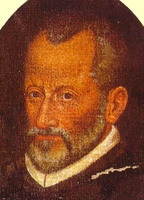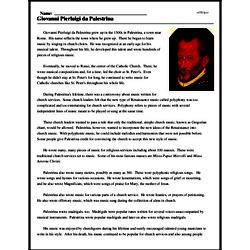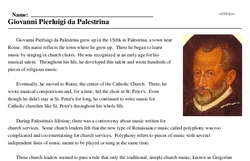Giovanni Pierluigi da Palestrina
Giovanni Pierluigi da Palestrina grew up in the 1500s in Palestrina, a town near Rome. His name reflects the town where he grew up. There he began to learn music by singing in church choirs. He was recognized at an early age for his musical talent. Throughout his life, he developed this talent and wrote hundreds of pieces of religious music.
Eventually, he moved to Rome, the center of the Catholic Church. There, he wrote musical compositions and, for a time, led the choir at St. Peter's. Even though he didn't stay at St. Peter's for long, he continued to write music for Catholic churches like St. Peter's throughout his whole life.
During Palestrina's lifetime, there was a controversy about music written for church services. Some church leaders felt that the new type of Renaissance music called polyphony was too complicated and too entertaining for church services. Polyphony refers to pieces of music with several independent lines of music meant to be played or sung at the same time.
These church leaders wanted to pass a rule that only the traditional, simple church music, known as Gregorian chant, would be allowed. Palestrina, however, wanted to incorporate the new ideas of the Renaissance into church music. With polyphonic music, he could include melodies and harmonies that were not possible before. Some people give Palestrina credit for convincing the church to accept this new style of music.
He wrote many, many pieces of music for religious services including about 100 masses. These were traditional church services set to music. Some of his most famous masses are Missa Papae Marcelli and Missa Aeterna Christi.




